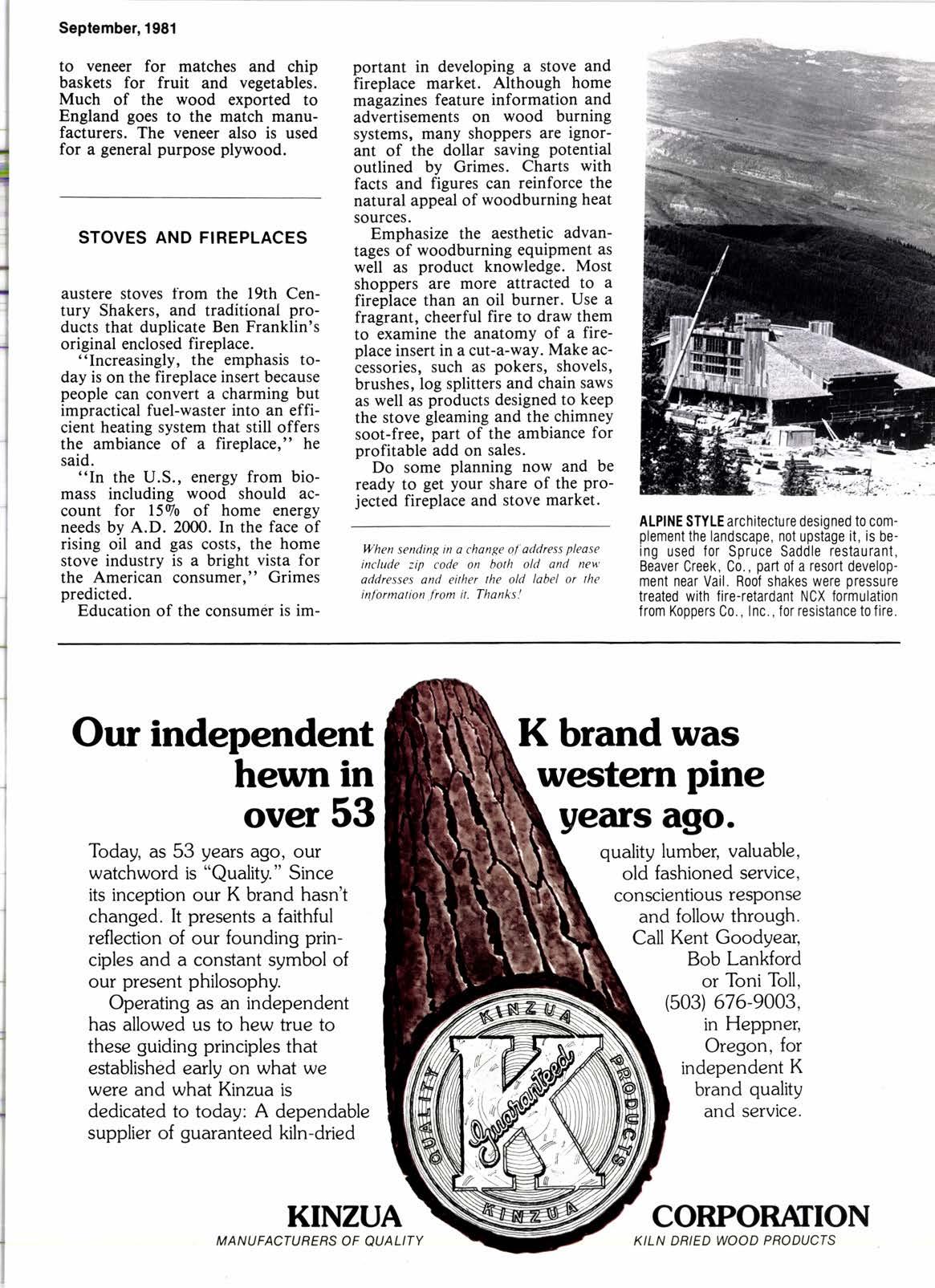
6 minute read
Wood Doors Save Energy
For the first impression at the front entry of a home, no other door material can compare with wood for natural beauty.
Wood doors can be stained, painted or otherwise finished to achieve a great variation of appearance. And nothing can beat the aesthetic satisfaction of a wood door closing solidly when a person enters a home.
But not everyone is aware of the energy efficiency afforded by wood doors. The millions of tiny honeycomb cells between wood fibers provide a high percentage of dead air volume, the best known insulation.
Wood is a natural thermal break. The interior surface of a wood door is not cold to the touch in winter. Condensation does not occur on them, nor do they freeze shut. Heat loss through a typical double entry wood panel door is 2890 less than through a sliding glass patio door.
The real story of energy efficiency, however, is around the edge of the door. A study by the U.S. Department of Housing and Urban Development states that the majority of heat loss occurs around the perimeter of the door, not through it, as many people believe. In fact, heat loss through the door accounted for 1.490 of the total heating load, while 590 was lost around the perimeters of those lacking good weatherstripping.
Independent laboratory tests, in accordance with American Society for Testing Materials (ASTM) standards, show that wood entry systems with single rabbeted wood frames, weatherstripping and oak sills with aluminum and vinyl sweeps have air infiltration rates in the range of 0.04 to 0.07 cubic foot per minute per lineal foot of perimeter, far exceeding published standards. The weatherstripped wood door also meets the toughest water infiltration standards (zero leakage) in the building products industry.
An important consideration in energy savings is how the door can be fitted and weatherstripped. This is an area where wood systems have always excelled, because wood doors can easily be trimmed and planed to custom-fit any entryway. Ordinary hand tools can produce a perfect fit, even when a door is being installed in an older structure where the entryway may have become out of plumb or out of square over the years.
Energy savings can also be realized with the use of insulated glass. The double panels of thermal glass trap a layer of dead air which acts as a natural insulator. The heat transfer or U-valve of a single pane of glass is approximately 1.10. The average U-valve of insulated glass, by comparison, is approximately 0.60; a reduction in heat transfer of nearly 5090.
For a specific example of the efficiency of a Thermal door, testing done on Simpson Timber Co.'s French-style insulated glass door rated it 640/o more energy-efficient than a French-style door manufactured with single pane glass. Sash doors with insulated glass are about 3790 more energy efficient than the same doors with single pane glass.
Poplar, aspen, or cottonwoo d?
I N IMPORTANT commercial rtimber, poplar (Populus spp.)
is divided into two main groups in the United States and Canada, the aspens and the cottonwoods, al-' though the label attached to that. sold as lumber is usually cottonwood with the pulpwood being called poplar regardless of species.
It is important to remember that poplar is also the name used for the timber of the American whitewood (Liriodendron, tulipifer) which is more commonly known as yellow poplar or tuliptree. (See The Merchant, p. 80, Sept., 1979)

The Canadian aspen, which also is found in the United States, is usually tall, 50 to 60 feet in height, with a trunk at least eight to twelve inches in diameter. The cottonwoods are a taller tree, reaching 100 feet or more in height and three to four feet in diameter. Usually vigorous growers, they are among the most productive temperate hardwoods.
Both groups supply generous amounts of timber as lumber, pulpwood and logs throughout most of Canada and the U.S. The fastgrowing hybrid poplars are widely cultivated in North and South America. Much of the Canadian aspen goes to Great Britain in log form to supplement European supplies.
Poplar wood is fairly soft and light with the average density for the different species varying between 25 and 29 pounds per foot when seasoned. Usually plain in appearance, except for the growth-ring figure on flat-sawn or rotary-cut material, it is greyish-white to light greyishbrown, sometimes with a reddish tinge. There is no sharp distinction between sapwood and heartwood. The grain is usually straight with a fine and even texture. Cottonwood is less fine in texture and has less luster than aspen. There is no odor or taste when the wood is well seasoned.
Story at a Glance
Poplar, whether an aspen or cottonwood, is important commercial hardwood useful for plywood, matches vigorous grower ... abun. dant in U.S. and Canada.
Care must be taken in seasoning as the wood tends to warp and twist. Since it is soft and light, poplar has a low strength rating. It can be compared to basswood and spruce. It ranks comparatively high in toughness and resistance to shock and wears evenly under abrasion, but is unsuitable for steam bending.
Damp conditions are destructive to all species of poplar. Since the heartwood is resistant to impregnation it will not take preservative treatment.
Poplar works easily and well with little splitting or splintering by both machine and hand if sharp, thinedged tools are used. Dull cutters tend to produce a wooly surface in planing or crumbling in end-grain cutting. [t nails, screws, and finishes well. The wood can be glued or painted easily. The logs peel readily to give a good veneer.
Poplar, which is important as a pulp wood, especially in the United States, is used for excelsior and flaked board products. It is also used as sawn wood for joinery and light structural work as well as flooring. Other major uses are for boxes and crates, and small domestic items such as kitchen utensils. The aspen particularly is converted
WESTERN to veneer for matches and chip baskets for fruit and vegetables. Much of the wood exported to England goes to the match manufacturers. The veneer also is used for a general purpose plywood.
A young aggnessive company with over 20 trading professionals anxious to senve YOU with all sizes, grades and varieties of plywood, lumben, shakes and shingles.
Stoves And Fireplaces
austere stoves tiom the l9th Century Shakers, and traditional products that duplicate Ben Franklin's original enclosed fireplace.
"Increasingly, the emphasis today is on the fireplace insert because people can convert a charming but impractical fuel-waster into an efficient heating system that still offers the ambiance of a fireplace," he said.
"In the U.S., energy from biomass including wood should account for l59o of home energy needs by A.D. 2000. In the face of rising oil and gas costs, the home stove industry is a bright vista for the American consumer," Grimes predicted.
Education of the consumdr is im- portant in developing a stove and fireplace market. Although home magazines feature information and advertisements on wood burning systems, many shoppers are ignorant of the dollar saving potential outlined by Grimes. Charts with facts and figures can reinforce the natural appeal of woodburning heat sources.
Emphasize the aesthetic advantages of woodburning equipment as well as product knowledge. Most shoppers are more attracted to a fireplace than an oil burner. Use a fragrant, cheerful fire to draw them to examine the anatomy of a fireplace insert in a cut-a-way. Make accessories, such as pokers, shovels, brushes, log splitters and chain saws as well as products designed to keep the stove gleaming and the chimney soot-free, part of the ambiance for profitable add on sales.
Do some planning now and be ready to get your share of the Projected fireplace and stove market.
Llhen sending in a change ol address please include zip code on both okl ancl nev' addresses and eilher the old label or the inlbrmation ftom it. Thanks.l
Over 53
'licday, as 53 years ago, our watchword is "Quality." Since its inception our K brand hasn't changed. It presents a faithful reflection of our founding principles and a constant symbol of our present philosophy.

Operating as an independent has allowed us to hew true to these guiding principles that established early on what we were and what Kinzua is dedicated to today: A dependable supplier of guaranteed kiln-dried quality lumber, valuable, old fashioned service, conscientious response and follow through. Call Kent Goodyear, Bob Lankford or Toni Toll, (503) 676-9003, in Heppner, Oregon, for independent K brand quality and service.
A[PltlE SIYLE architecture designed to complement the landscape, not upstage it, is being used lor Spruce Saddle restaurant, Beaver Creek, Co., part of a resort development near Vail. Roof shakes were oressure treated with fire-retardant NCX formulation from Koppers Co., Inc., for resistance to fire.










